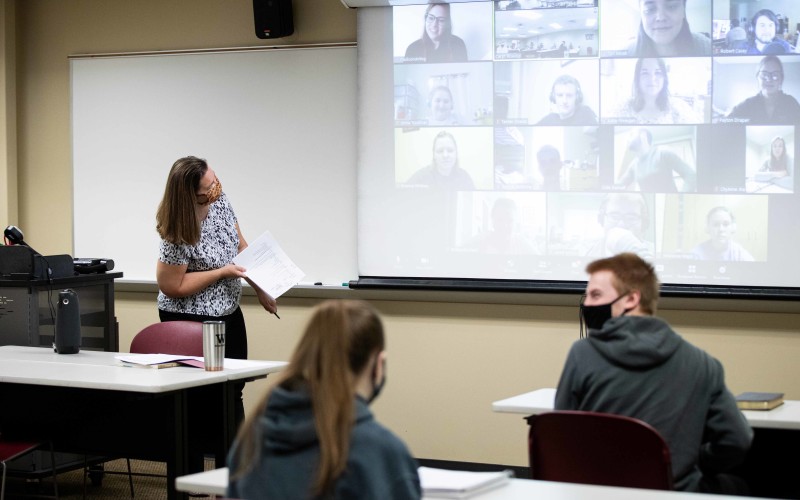Special cameras allow for immersive hybrid classrooms
September 10, 2020

By Katie Hirv ’22 | Photos Julie Pagel Drewes ’90
Though COVID-19 has forced Wartburg College professors and students to adapt to new classroom settings, the new and unique circumstances have brought about creative solutions.
Dr. Caryn Riswold, professor of religion, is teaching courses that are hybrid and synchronous this fall with the help of Zoom, a popular cloud-based video communications software used by many Wartburg staff and faculty.
“For me, hybrid means that half of the students are assigned to be ‘in the room’ and half are assigned to be ‘in the Zoom’ every class session, with the two groups alternating. So a student is ‘in the room’ one class session and ‘in the Zoom’ the next class session,” she said.
When students are “in the Zoom,” Riswold and many other professors are relying on the Meeting Owl, a conferencing camera that captures a 360-degree view and audio of the room, to allow them to safely interact with and educate their students.
“With the 360-degree view, remote students can see the classroom, the people, and the space. When multiple students start talking or the instructor moves while speaking, the camera automatically follows and splits into up to three different panels on the bottom of the screen,” said Loni Abbas, assistant vice president for information technology services.
The camera technology, which is now installed in 55 classrooms on campus, pairs with all popular video conferencing platforms, including Zoom.
“I learned quickly how to get the camera to follow me. I tried whistling, but then learned that clapping was more effective,” said Dr. Zak Montgomery, associate professor of Spanish, who is also teaching in a hybrid form this fall. “Then I realized that I could yell, ‘¡Oye, búho!’ (Hey, Owl!) in Spanish, and it would ‘spin its head’ and focus on me as I moved around. This is more fun anyway.”

For some professors, the Owls have allowed them to continue with the school year in a format that is as close to normal as possible.
“With the Meeting Owl, a live, in-the-classroom experience has been restored after the pandemic took it away from us all in March. The dynamic and embodied conversations that are a regular feature of how and why I teach can happen again, and they can include students who are physically and virtually present via the Meeting Owl,” said Riswold. “It enables me to accommodate any student who is in quarantine or ill but still able to attend class. It makes it possible for me to ensure students have equitable access to the classroom and our discussions.”
Montgomery added that “students who can’t come to class due to COVID are able to engage in the same learning activities. Also, since everyone is on Zoom once a week, they are already familiar with the format and it’s not as disruptive should they have to isolate themselves.”
The Owls also have helped ease some students’ worries about learning remotely.
“It has been helpful in my classes that require large groups to meet in small spaces. It allows me to feel like I’m still in the classroom even though I am sitting in my dorm,” said Micah Decker, a third-year elementary education major.
Looking ahead, Abbas is excited for some new opportunities that may help the Owls become an even more integral part of the remote learning experience.
“We can get two of the Owls to pair with each other so they can share large spaces. You don’t have the feedback problem that you’d have with multiple microphones because they know when to switch off,” said Abbas. “Another feature that is still in beta testing is to be able to better show a whiteboard. It’s supposed to do something with contrast to boost the image to better show students over Zoom what’s on the whiteboard.”
Although their time on campus has been short, the Owls are quickly becoming vital components of academic life.
“I’m really grateful to my colleagues who worked so hard to obtain these and set them up. It’s made the fall much better than I would have planned given the circumstances. I also see a lot of really interesting possibilities to reach students who are not in Waverly in our program in the future,” said Montgomery.
“I can’t imagine teaching this fall without it,” Riswold added.
